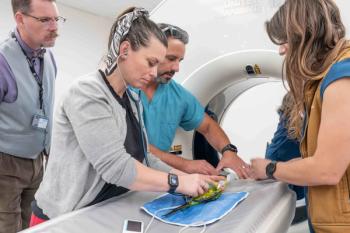
Thoracic viscera: disease processes defined with radiography and ultrasound (Proceedings)
The survey ultrasound study is primarily used to assess soft tissue composition and in some cases function (echocardiogram) as well as guide you in biopsying "soft tissue" lesions. It has limited value in assessing bone-primarily restricted to the bone surface and it has no value in evaluating gas other than letting you know gas is present.
Conditions I "routinely see" that altered the trachea:
• Congenital Malformation (hypoplasia)
• Trauma
• Neoplasia
• Foreign body
• Chondromalacia
• Infection
Conditions I "routinely see" that alter of the bronchi:
• Bronchitis
• Bronchiectasis
Pathology of the lung:
• Alveolar air spaces
• Interstitial tissues
• Airways
• Vessels
Radiographic findings when disease processes involve the alveolar:
o Air bronchograms
o Air Alveolograms
o Ill-defined infiltrates
o Lobar border visualization
Radiographic findings when disease processes involve the interstitial tissues:
o Interstitial Pattern:
• Short linear opacities crisscross randomly
• Nodular densities round or irregular in contour with well-defined borders,
• admixture linear and nodular densities.
Radiographic findings when disease processes involve the bronchi and vessels
o Bronchovascular Pattern:
• Vessel or conducting airways change in appearance
• Increased prominence
• Decreased prominence
• Ill-defined borders
Vessels - Cranial lung lobe vessels (artery or vein) at edge of cardiac silhouette should be approximately 3/4 diameter of the 3rd or 4th rib at approximately the level of the trachea; the transverse diameter of the vessels should be equal to each other.
Changes seen in vessel size with disease:
Changes normally seen as animal ages ("normal for age")
• Pleural thickening
• Increased linear markings - interstitial fibrosis
• Nodular densities - occasionally calcified - metaplasti mineralization-alveolar microlithiasis, osteomata
• Increased density of tracheal and bronchial walls - mineralized cartilages
• Hyperlucency -emphysema, air trapping
The lung - radiographic assessment:
Like any other organ, the lung can respond to noxious stimuli in a finite number of ways. One can try to memorize a distinctive radiographic appearance for each type of lung lesion; however, the final result will probably be utter frustration as the lung changes all begin to look alike. As such, a systematic approach based on morphoanatomic structures is suggested. The basis for this system is pattern recognition; once the pattern is recognized, then a list of differential diagnoses can be made. Subsequent tests can be performed to exclude or confirm a diagnosis.
When evaluating the lungs, you should know:
• Pattern of involvement
• Lung lobes/regions involved
• History
Which lung lobes are involved?
One should determine which lung lobes are involved: cranial, middle, caudal, accessory. The distribution of the disease process is often a vital clue to the likely etiology i.e. cranioventral lung field—often infection; hilar region—often cardiogenic edema in dogs.
Which side is involved?
A dorsoventral or ventrodorsal radiograph should be obtained so that right and left portions of the thoracic cavity can be compared. An animal traumatized by a car may have severe pulmonary contusion that involves only one side of the thorax. If only a lateral radiograph is obtained, this lesion may be missed if it is in the "down" side".
Which area is involved?
The area of involvement is an important clue to the possible etiology of the lesion.
The caudal lung lobes are often most severely involved in diseases resulting from inhalation of noxious agents or blood-born parasitic, infectious or toxic agents. This results because the largest percentage of inhaled gases goes to the caudal lung lobes, and the caudal lung lobes receive the largest percentage of blood pumped from the right ventricle. As such, the caudal lobes receive the largest insult when the noxious agent is carried in the air or by the blood stream.
The dependent portions of the lungs become involved in aspiration pneumonia and many bacterial pneumonias because the particles which are aspirated are relatively heavy and cannot be carried up into the caudal lung lobes. Therefore, they settle in the ventral (dependent) portion of the lung lobes, especially the cranial and middle lobes. An exception to this distribution may occur if the animal aspirates material while being held upright - in this case the caudal lung lobes will be involved.
The hilar area of the lungs is most commonly involved in cardiac edema while the periphery of the lungs is involved in neurogenic edema.
Which region is involved?
Finally, in the dorsoventral or ventrodorsal radiograph, the lung can be divided into three regions - central or hilar, middle and peripheral. The region involved often gives an important clue as to the etiology. In pulmonary edema of cardiac origin, the central or hilar region located directly over the heart and caudal mediastinum are most severely involved while in pulmonary edema secondary to electrocution, the peripheral regions of the lung are most severely involved.
When do I use radiology versus when do I use ultrasound?
• Radiology—gas is our friend/fluid is our foe
• Ultrasound-fluid is our friend/gas and bones are our foes
• Too much fat is not so good with either imaging method.
The survey radiographic study enables you to appreciate the size and contour of "soft tissue" structures. The technology does not enable you to distinguish between fluid and solid soft tissue structures.
The survey ultrasound study allows you to appreciate the size, contour and composition of the soft tissue structures. The technology enables you to distinguish between fluid and soft tisue cellular structures.
You cannot image through gas or bone with high frequency sound (ultrasound).
The survey ultrasound study is primarily used to assess soft tissue composition and in some cases function (echocardiogram) as well as guide you in biopsying "soft tissue" lesions. It has limited value in assessing bone-primarily restricted to the bone surface and it has no value in evaluating gas other than letting you know gas is present.
Newsletter
From exam room tips to practice management insights, get trusted veterinary news delivered straight to your inbox—subscribe to dvm360.






